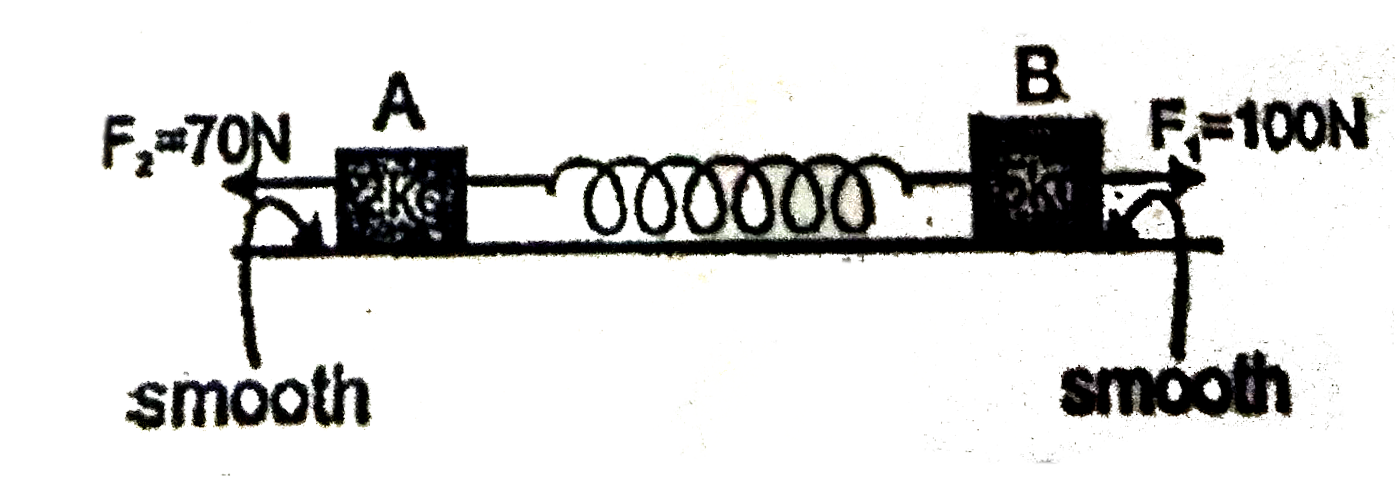STATEMENT -1 : Net force on a particle w.r.t an inertial frame does notdepend on the velocity of the intertial frame. ,
STATEMENT - 2 : If net force on A is →FA and net force on B is →FB then force on A w.r.t B is (ven(F)A−→FB) .
STATEMENT - 2 : If acceleration of A is →aA and acceleration of B is →aB then, the acceleration of A w.r.t B is (→aA−→aB)
F T F
T F T
T T F
F T T
The correct Answer is:B
Step by step video, text & image solution for STATEMENT -1 : Net force on a particle w.r.t an inertial frame does notdepend on the velocity of the intertial frame. , STATEMENT - 2 : If net force on A is vec(F)_(A) and net force on B is vec(F)_(B) then force on A w.r.t B is (ven(F)_(A) - vec(F)_(B)) . STATEMENT - 2 : If acceleration of A is vec(a)_(A) and acceleration of B is vec(a)_(B) then, the acceleration of A w.r.t B is ( vec(a)_(A) - vec(a)_(B)) by Physics experts to help you in doubts & scoring excellent marks in Class 12 exams.
Topper's Solved these Questions
- BOOK - AAKASH INSTITUTECHAPTER - LAWS OF MOTIONEXERCISE - ASSIGNMENT ( SECTION -I ) Subjective Type Questions3videos
LAWS OF MOTION
- BOOK - AAKASH INSTITUTECHAPTER - LAWS OF MOTIONEXERCISE - ASSIGNMENT ( SECTION -J ) Aakash Challengers Questions5videos
LAWS OF MOTION
- BOOK - AAKASH INSTITUTECHAPTER - LAWS OF MOTIONEXERCISE - ASSIGNMENT ( SECTION -G ) Integer Answer Type Questions2videos
LAWS OF MOTION
- BOOK - AAKASH INSTITUTECHAPTER - KINETIC THEORYEXERCISE - EXERCISE (ASSIGNMENT) SECTION - D Assertion - Reason Type Questions10videos
KINETIC THEORY
- BOOK - AAKASH INSTITUTECHAPTER - MAGNETISM AND MATTER EXERCISE - ASSIGNMENT (SECTION D)26videos
MAGNETISM AND MATTER
Similar Questions
Two constant horizontal force F1 and F2 are acting on blocks A and B. At an instant acceleration of block B is 4m/s2 in direction of F1 and acceleration of block A w.r.t block B at this moment is:
 View Solution
View SolutionIn an inertial frame of reference, the magnetic force on a moving charged particle is F. Its value in another inertial frame of reference will be
View Solution
Knowledge Check
- Question 1 - Select One
Two forces →F1=500N due east and →F2=250N due north have their common initial point. →F2−→F1 is
A250√5N,tan−1(2)WofNB250N,tan−1(2)W of NCZeroD750N,tan−1(3/4)NofW - Question 2 - Select One
STATEMENT-1 : Acceleration of a particle in a reference frame may be non- zero , even if net external force acting on the particle is zero.
and
STATEMENT : 2 In a non- - inertial reference frame, Newton's second law is not valid.AStatement -1 True, Statement -2 is True , Statement - 2 is a correct explanation for Statement -7BStatement -1 is True , Statement -2 is True , Statement -2 is NOT a correct explanation for statement -7CStatement -1 is true, Statement -2 is FalseDStatement - 1 is False , Statement - 2 is True - Question 3 - Select One
When force →F1,→F2,→F3 are acting on a particle of mass m, the particle remains in equilibrium. If the force →F1 is now removed then the acceleration of the particle is :
A→F1/mB→F1/mC→F2−→F3/mD→F2/m
When force −→F1,−→F2,−→F3…...−→Fn act on a particle , the particle remains in equilibrium . If −→F1 is now removed then acceleration of the particle is
View SolutionIf →F is the force acting in a particle having position vector →r and →τ be the torque of this force about the origin, then
View SolutionTwo forces −→F1and−→F2 are acting at right angles to each other , find their resultant ?
View SolutionIn the nucleus of helium if F1isthe≠tforcebetweentwopro→ns,F_2isthe≠tforcebetweentwo≠utronsandF_3 is the net force between a proton and a neutron. Then,
View SolutionIf θ is smaller angle between force vector →F and velocity vector →v then Fv cos θ represents
View Solution

